Question
The diagram shows a seedling growing in a pot in the light.
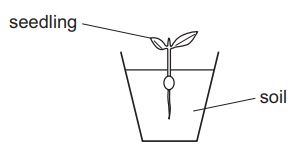
The pot was then placed on its side in a dark room.
What will be the appearance of the seedling after 48 hours?

▶️Answer/Explanation
D
When a seedling is placed on its side in a dark room, it will exhibit a response known as gravitropism, which is the growth and orientation of plants in response to gravity. In the absence of light, the seedling will also undergo etiolation, which is a morphological adaptation to low light conditions.
After 48 hours in the dark, the seedling will display noticeable changes:
1. The stem of the seedling will grow longer as it attempts to reach for a light source. This is an adaptation called “stem elongation” or “etiolation.” The stem will appear stretched and thin compared to a seedling grown in light.
2. In the absence of light, root growth may be inhibited or slowed down. Roots typically grow towards gravity, but without light, the seedling may not have a clear orientation for root growth.
Overall, the seedling will appear elongated, pale, and weak after 48 hours in the dark. Once exposed to light again, it will undergo phototropism, bending towards the light, and start the process of photosynthesis to regain its healthy appearance.
Question
The diagram shows an experiment to investigate photosynthesis.
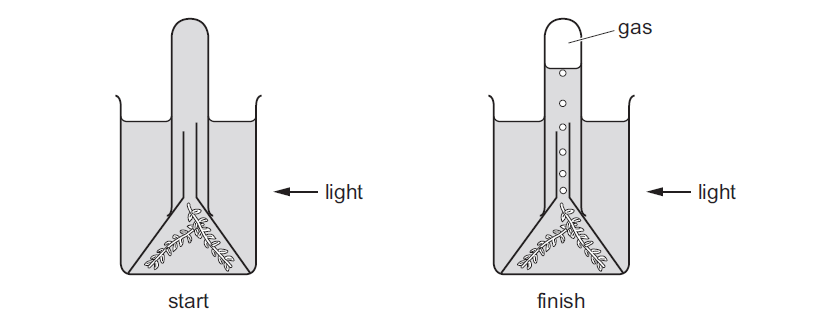
What is the most abundant gas present at the top of the tube at the end of the experiment?
A carbon dioxide
B methane
C sulfur dioxide
D oxygen
▶️Answer/Explanation
D
To determine the most abundant gas present at the top of the tube at the end of the photosynthesis experiment, we need to consider the process of photosynthesis. Photosynthesis is the biological process by which plants, algae, and some bacteria convert light energy into chemical energy, producing oxygen and glucose from carbon dioxide and water. We can eliminate options B (methane) and C (sulfur dioxide) because they are not typically involved in the process of photosynthesis.
During photosynthesis, plants absorb carbon dioxide from the surrounding environment and release oxygen as a byproduct. Therefore, at the end of the experiment, the most abundant gas present at the top of the tube would be oxygen.
Question
What is the principal source of energy input to biological systems?
A carbon dioxide in air
B glucose
C minerals in soil
D sunlight
▶️Answer/Explanation
D
The principal source of energy input to biological systems is D) sunlight. Sunlight is the primary source of energy for most ecosystems on Earth. It provides the energy needed for photosynthesis, the process by which green plants and some other organisms convert sunlight into chemical energy in the form of glucose. Glucose is then used as a source of energy by living organisms to carry out various cellular processes and activities. While carbon dioxide (A) and minerals (C) are important for plant growth, they are not the primary sources of energy input. Glucose (B) is a product of photosynthesis and can be used as an energy source, but the ultimate source of energy is sunlight.
Question
The diagram shows an experiment to investigate the balance between respiration and
photosynthesis.
In which tube are photosynthesis and respiration taking place at the same time?

▶️Answer/Explanation
C
The tube in which photosynthesis and respiration are taking place at the same time is C where water and light are present with pond weed. Photosynthesis occurs in the presence of light, where plants use sunlight, water, and carbon dioxide to produce oxygen and glucose. Respiration, on the other hand, is a continuous process in plants where glucose is broken down in the presence of oxygen to release energy.
In the mentioned tube, the pond weed is exposed to light, which allows photosynthesis to occur. The pond weed takes in carbon dioxide from the water and releases oxygen as a byproduct. At the same time, the pond weed also consumes oxygen through respiration, using it to break down glucose and release energy.
Therefore, in the tube with water and light, photosynthesis and respiration are happening simultaneously, maintaining a balance between the two processes.
Question
Two sealed test-tubes containing aquatic plants and hydrogencarbonate indicator were set up.
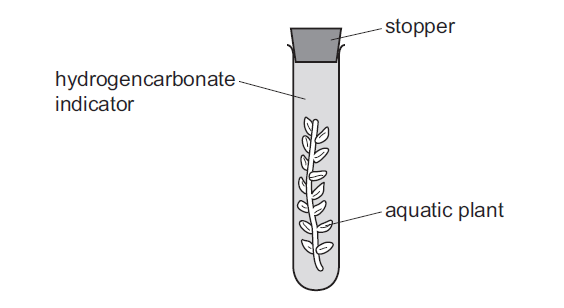
The indicator in the sealed test-tubes shows the concentration of dissolved carbon dioxide
present.
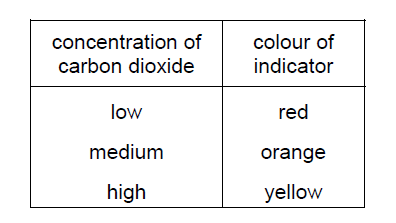
One of the sealed test-tubes was kept in the light for 24 hours and one of the sealed test-tubes
was kept in the dark for 24 hours.
The results are shown in the table.
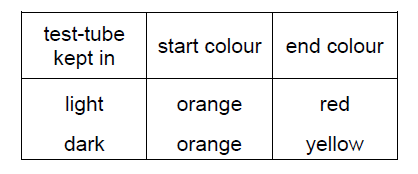
What is the correct explanation of what has taken place?
A Photosynthesis and respiration both occur in the light, but the rate of photosynthesis is
higher.
B Photosynthesis occurs in the light, but respiration does not.
C Respiration can only occur when photosynthesis is not taking place.
D The amount of carbon dioxide used and produced in the light is equal.
▶️Answer/Explanation
A
Photosynthesis is the process by which plants, algae, and some bacteria convert sunlight, carbon dioxide, and water into glucose (a form of stored energy) and oxygen. This process primarily takes place in specialized cell structures called chloroplasts, which contain a pigment called chlorophyll. Chlorophyll absorbs light energy from the sun, which is then used to power the chemical reactions involved in photosynthesis.
Respiration, on the other hand, is the process by which organisms release energy from glucose and convert it into a usable form called adenosine triphosphate (ATP). Respiration occurs in all living cells, including plant cells, and is essential for the survival and functioning of organisms. It involves the breakdown of glucose molecules in the presence of oxygen, producing carbon dioxide, water, and ATP.
In terms of their occurrence, photosynthesis primarily occurs in the presence of light, specifically in the chloroplasts of plants’ green leaves. It is a light-dependent process and requires sunlight to drive the synthesis of glucose. Respiration, on the other hand, occurs both in light and darkness, as it is not solely reliant on light energy. The rate of photosynthesis is typically higher in the presence of light because light provides the necessary energy for the process to occur efficiently.
Therefore, photosynthesis and respiration are distinct processes that occur in plants. Photosynthesis relies on light energy to convert carbon dioxide and water into glucose and oxygen, while respiration involves the breakdown of glucose to release energy. Photosynthesis occurs primarily in the presence of light, and its rate is typically higher than that of respiration when light is available.
